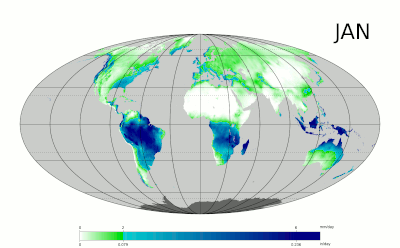Portal:Weather/Selected article/18
In meteorology, precipitation is a term for any product of the condensation of atmospheric water vapour that is deposited on the Earth's surface. It occurs when the atmosphere, becomes saturated with water vapour and the water condenses, falling out of solution. Two processes, possibly acting together, can lead to air becoming saturated: cooling the air or adding water vapour to the air. Precipitation forms via collision with other rain drops or ice crystals within a cloud.
Precipitation that reaches the surface of the earth can occur in many different forms, including rain, freezing rain, drizzle, ice needles, snow, ice pellets or sleet, graupel and hail. While snow and ice pellets require temperatures to be near or below freezing at the surface, hail can occur during much warmer temperature regimes due to the process of its formation. Precipitation also occurs on other celestial bodies—including snow on Mars and a sulfuric acid rain on Venus—though both of these evaporate before reaching the surface.
Moisture overriding associated with weather fronts is a major method of precipitation production. If enough moisture and upward motion is present, precipitation falls from convective clouds such as cumulonimbus and can organize into narrow rainbands. Precipitation can also form due to forced ascent up the windward side of a mountain or mountain range. Precipitation is a major component of the water cycle, and is responsible for depositing essentially all of the fresh water on the planet. Approximately 505,000 km3 (121,000 cu mi) of water falls as precipitation each year; 398,000 km3 (95,000 cu mi) of it over the oceans.

Recently selected articles: Super Tuesday tornado outbreak, Cyclone Elita, More...
